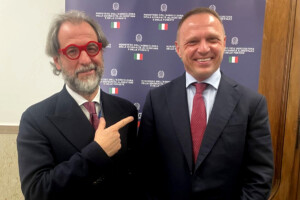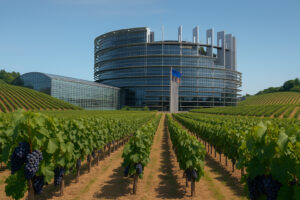Once again, no Italian wine puts all the national “print run” guides in agreement: the best ones, capable of being rewarded by seven publications (out of nine), are two icons like the Sassicaia 2016 of Tenuta San Guido of the Incisa family of Rocchetta and the San Leonardo 2015 of Tenuta San Leonardo of the Guerrieri Gonzaga family, awarded the highest quality awards by the 2020 guides of Gambero Rosso, Slow Wine, Doctor Wine by Cernilli, Vitae-Ais Italian Sommelier Association, Bibenda, Veronelli and L'Espresso. A result that substantially reaffirms the bizarre nature of the “guide” panorama of the Belpaese.
As mentioned, the total number, 9, of the national wine guides for Italian wines also includes the one published by the Touring Club, “Vinibuoni d’Italia”, excluded from our analysis for its declared choice to attribute the “Corona” to the only wines from autochthonous vines, as well as the “Yearbook of the best Italian wines” by Luca Maroni for its particular selection criterion (wines that score the highest score of the pleasure index do nothing but express a wine “the pleasantness of its taste, or its fruitiness”, ed).
The use of Slow Wine wines (a special classification that only evaluates wines that are “good, clean and fair”) has been omitted. For L’Espresso, which, since the 2019 edition, has “unified” its oenological choices into the restaurant guide, its use has been partial, since it seems that a different editorial path has been taken from that normally followed by “pure” wine guides (the “Three Glasses” of the Gambero Rosso guide Vini d’Italia, the “Tre Stelle” of the “I Vini di Veronelli” guide of the Luigi Veronelli Permanent Seminar), the “Cinque Grappoli” of the “Bibenda” guide of the Italian Sommelier Foundation (FIS), the “Grande Vino”, that is the best from an exquisitely organoleptic point of view for Slow Wine by Slow Food, the “faccino score”, assigned to wines evaluated with 95/100 or more, from the “Guida Essenziale ai Vini d’Italia” by Daniele Cernilli (Doctor Wine) and the “Quattro Viti”, the highest recognition of “Vitae - La Guida dei Vini 2019” dell’Associazione Italiana Sommelier-Ais.
As always, no account has been taken of the scales of scores (hundredths, tenths) or the different criteria of judgement, sometimes very distant, which are considered in addition to the absolute quality of the wines examined.
The WineNews analysis (edition no. 14), therefore, simply crossed all the lists of the best tastings, also highlighting some alternative scenarios. If we examine the publications of Doctor Wine, Gambero Rosso, Slow Food and Espresso, the wines awarded by all these guides become five: Quintarelli, Amarone Della Valpolicella Classico 2011, Roagna Barbaresco Crichet Pajé 2011, Giacomo Conterno, Barolo Monfortino Riserva 2013, Tenuta San Guido, Bolgheri Sassicaia 2016 and Tenuta San Leonardo, San Leonardo 2015.
Remaining always with four guides, but leaving out the “partial” visions of Espresso (“top 100” associated with the restaurant guide) and Slow Wine (only “Grandi Vini”) and then comparing Ais, Bibenda, Veronelli and Gambero Rosso, which, substantially, they maintain “guides true to themselves”, the award-winning wines are soaring to 30 (31 if we consider the Furore Bianco Fiorduva of Marisa Cuomo that has resubmitted the same “problem” that occurred last year, and that is the fact that some guide tastes and rewards 2017, instead, that 2018). Wines that are the Barbaresco Asili 2016 by Ceretto, the Barbaresco Asili Riserva 2014 by Bruno Giacosa, the Barbaresco Sorì Tildìn 2016 by Gaja, the Barolo Aleste 2015 by Sandrone, the Barolo Brea Vigna Ca 'Mia 2015 by Brovia, the Barolo Bricco delle Viole 2015 by Vajra, Barolo Monvigliero 2015 by Fratelli Alessandria, Barolo Serra 2015 by Giovanni Rosso, Barolo Villero Riserva 2012 by Vietti, Amarone della Valpolicella Classico De Buris Riserva 2009 by Tommasi, Amarone della Valpolicella Classico Sant’Urbano 2015 by Speri, the San Leonardo 2015 of Tenuta San Leonardo, the Trentodoc Madame Martis Rare Vintage Reserve 2009 by Maso Martis, the Trentodoc Giulio Ferrari Reserve of the Ferrari Founder 2008, the Alto Adige Lagrein Taber Reserve 2017 of Cantina Bolzano, the Rossazzo Terre Alte 2017 of Livio Felluga, Romagna Sangiovese of Predappio Vigna of General Reserve 2016 of Nicolucci, Bolgheri Sassicaia 2016 of Tenuta San Guido, Bolgheri Superiore Grattamacco 2 016 of Grattamacco (ColleMassari Group), the Cepparello 2016 of Isole and Olena, the Solaia 2016 of Antinori, the Montefalco Sagrantino 25 Years of Caprai, the Torgiano Rubesco Vigna Monticchio Riserva 2015 of Lungarotti, the Rosso Piceno Superiore Roggio of the Filare 2016 Velenosi, the Verdicchio di Matelica Cambrugiano Reserve 2016 by Belisario, the Molise Don Luigi Reserve 2015 by Di Majo Norante, the Sabbie di Sopra Il Bosco 2017 by Nanni Copé, the Aglianico del Vulture Don Anselmo 2016 by Paternoster, the Carignano del Sulcis Superiore Terre Brune 2015 of Santadi, the Turriga 2015 of Argiola and, lastly, the Amalfi Coast Furore Bianco Fiorduva 2017 or 2018 by Marisa Cuomo.
Moving on to a comparison of five, with the addition of the Doctor Wine guide, alias Daniele Cernilli, to be considered in the “classic” channel, the number of award-winning wines is reduced to 16 or 17 (in this case, the White Furore by Marisa Cuomo is awarded the 2017 vintage): the Barbaresco Asili 2016 by Ceretto, the Barbaresco Asili Riserva 2014 by Bruno Giacosa, the Barbaresco Sorì Tildìn 2016 by Gaja, the Barolo Aleste 2015 by Sandrone, the Barolo Brea Vigna Ca ’Mia 2015 by Brovia, the Barolo Bricco delle Viole 2015 by Vajra, the Barolo Villero Riserva 2012, the Amarone della Valpolicella Classico De Buris Riserva 2009 by Tommasi the San Leonardo 2015 by Tenuta San Leonardo, the Trentodoc Giulio Ferrari Reserve by the 2008 Ferrari Founder , the Sangiovese Romagna of Predappio Vigna of the General Reserve 2016 of Nicolucci, the Bolgheri Sassicaia 2016 of Tenuta San Guido, the Bolgheri Superiore Grattamacco 2016 of Grattamacco, the Cepparello 2016 of Isole and Olena, the Solaia 2016 of Antinori, the Montefalco Sagrantino 25 Years 2015 of Caprai, the Torgiano Rubesco Vigna Monticchio Reserve 2015 by Lungarotti, the Rosso Piceno Superiore Roggio of the Filare 2016 by Velenosi, the Sabbie di Sopra Il Bosco 2017 by Nanni Copé, and finally the Costa d’Amalfi Furore Bianco Fiorduva 2017 by Marisa Cuomo.
Drastic drop in two wines compared to 6 guides (Gambero Rosso, Slow Wine, Doctor Wine by Cernilli, Vitae-Ais Italian Sommelier Association, Bibenda, Veronelli) - which remain Tenuta San Guido, Bolgheri Sassicaia 2016 and Tenuta San Leonardo, San Leonardo 2015 - which is also maintained in consideration of 7 guides (adding L’Espresso) out of 9, therefore (leaving aside only Vini Buoni d’Italia and Maroni).
Focus - The “Ranking of Rankings” ... in past years
2018: no wine
2017: no wine
2016: no wine
2015: no wine
2014: Tenuta San Guido, Bolgheri Sassicaia 2011
2013: Gianfranco Fino, Primitivo di Manduria Es 2011
2012: no wine
2011: Tenuta San Guido, Bolgheri Sassicaia 2008, Gianfranco Fino Primitivo di Manduria Es 2009
2010: Termeno Alto Adige Gewürztraminer Vendemmia Tardiva “Terminum” 2007, Oasi degli Angeli Kurni 2007
2009: Cantina di Caldaro, Moscato Giallo Passito “Serenade” Castel Giovanelli 2005
2008: Tenuta San Leonardo San Leonardo 2003, Montevetrano Montevetrano 2005, Galardi Terre di Lavoro 2005, Tenuta San Guido Bolgheri Sassicaia 2004, Cantina di Caldaro Moscato Giallo Passito “Serenade” Castel Giovanelli 2004
2007: Fattoria di Petrolo Galatrona 2004, Montevetrano Montevetrano 2004
2006: Gaja Sorì San Lorenzo 2001, Casanova di Neri Brunello di Montalcino Cerretalto 1999, Masciarelli Montepulciano d’Abruzzo Villa Gemma 2001, Oasi degli Angeli Kurni 2003, Galardi Terra di Lavoro 2003, Montevetrano Montevetrano 2003, Sandrone Barolo Cannubi Boschis 2001, Foradori Granato 2003
Copyright © 2000/2025
Contatti: info@winenews.it
Seguici anche su Twitter: @WineNewsIt
Seguici anche su Facebook: @winenewsit
Questo articolo è tratto dall'archivio di WineNews - Tutti i diritti riservati - Copyright © 2000/2025









































































































































































































